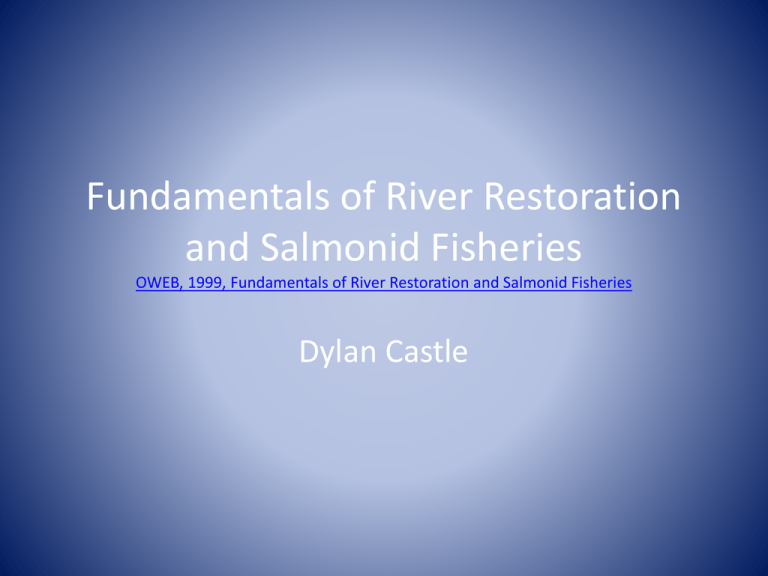Fundamentals of River Restoration and Salmonid Fisheries Dylan Castle
advertisement

Fundamentals of River Restoration and Salmonid Fisheries OWEB, 1999, Fundamentals of River Restoration and Salmonid Fisheries Dylan Castle Overview • • • • • • • • • What is a Watershed? Patterns in Watershed Conditions Water Dynamics Soil and Sediments Vegetation Wetlands Water Quality Fisheries Resources Conclusion What is a Watershed • “Area of land that drains downslope to the lowest point”- OWEB – Drainage pathways can be surficial or underground • Assessments should occur at the watershed level due to connectivity • Activity affecting the watershed at one location will affect the watershed downstream What is a Watershed Cont. • Watersheds are broken into categories – River Basins – Sub-basins – Watershed • Sub-watershed • Drainage • Site Regional Patterns in Watershed Conditions • Watersheds determined by geology, climate, and disturbances – Geology: uplifting can influence slope and orientation of bedrock – Climate: elevation, precipitation, and vegetation – Disturbances: large or small scale • • • • Small Scale: trees blown into a stream Large Scale: fire or flood Natural part of watershed evolution Human activities can increase timing and intensity – i.e. roads creating impervious surfaces Water Dynamics Water Cycle • Precipitation uses three pathways on Earth’s surface —Intercepted by vegetation and evaporated or transpired back to atmosphere —Move downslope on surface or through soil to stream system —Stored in snowpack, groundwater, ponds, or wetlands for a period of time Water Dynamics Cont. • Precipitation is generally less than infiltration rates – Little surface runoff or overland flows occur • Decreases in infiltration rates can cause larger peak flows – Reduce water storage and result in low flows Hydrologic Data • Steep slopes and/or thin soil move water relatively quickly • Larger watersheds, deep soils, and extensive storage sites tend to move water slower Soil Erosion and Sediment in Streams • Sediment Derived from – Erosion of upland areas – Lateral movement of stream channels – Downcutting of stream beds • Sediment balance is important – Fine sediment can blanket spawning gravel and cover rock surfaces for insects – Suspended sediments can cloud water Soil Erosion and Sediment in Streams Cont. • Humans have little control over natural sedimentation – Organisms have adapted to local sedimentation rates • Can only control human-induced sedimentation • Some sources of Sediment – – – – Slope instability Urban runoff Surface erosion from crop, range, and burned land. Road instability Soil Erosion • Number of mechanisms can move soil downhill or into streams – Raindrop Splash: splattered soil grain from raindrops, can accumulate downhill – Ravel: movement of soil downhill from gravity – Surface rilling: soil carried by overland flow. – Landslides Soil Erosion • Mass Wasting (creeps and flows): gravity moves soil downhill Vegetation • Factors of Vegetation – Water temperature – Sediment delivery • Reduces soil compaction – Amount and timing of runoff • Filters Toxins – Food and shelter for living organisms – Large woody debris – Decrease erosion Riparian Zones Vegetation decreases fluctuation of water temperatures Wetlands • Provide Variety of important functions – Water quality improvement • Assimilate nutrients and filter toxins – Flood attenuation and desynchronization • Alleviate flooding by storing water or delaying runoff – Groundwater recharge and discharge • Recharge aquifers by storing water – Fish and wildlife • Provide food and habitat Water Quality • Nutrients – Stimulate growth of algae and plants • Produce food for aquatic insects which are eaten by fish • Excessive growth (blooms) can cause oxygen deficiencies • Phosphorous and nitrogen are controlling nutrients and are monitored most • Bacteria – Used to test water quality for drinking – Indicate contamination by sewage, feedlots, grazing, and urban runoff Water Quality Cont. • Cool Temperatures and dissolved oxygen – Essential for salmonids and aquatic community – 64oF established as basis of sub-lethal for salmonids • Toxic Contaminants – Runoff from pesticides or herbicides – Urban runoff Fisheries Resource • Best indicator of watershed health Fisheries Resource • Chinook (king) – Spawn in large main channels • Coho – Spawn in small, lowgradient tributaries • Sockeye – Spawn in lakes • Steelhead and Trout – Spawn in tributaries Human Impacts Human Impacts Cont. Conclusion • Watershed: area of land that drains downslope to the lowest point • Watersheds determined by geology, climate, and disturbances • Can only control human-induced sedimentation • Vegetation is critical in healthy watersheds • Water quality is vital for living organisms



